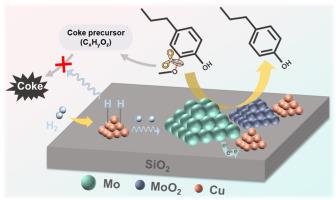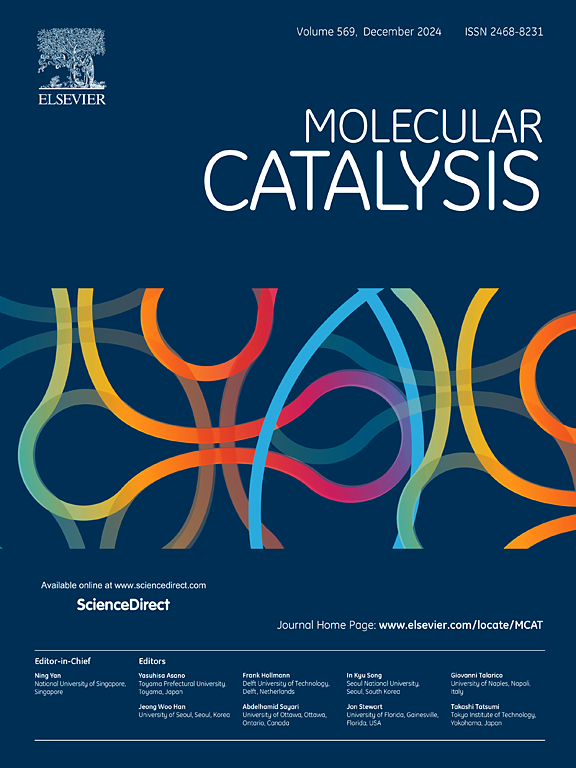溶胶-凝胶法制备的 Cu-Mo-SiO2 催化剂上 Cu 和 Mo 的协同效应用于木质素衍生的 4-丙基愈创木酚的高效稳定脱甲氧基化反应
IF 3.9
2区 化学
Q2 CHEMISTRY, PHYSICAL
引用次数: 0
摘要
由于钼基催化剂在 C-O 键裂解方面具有独特的行为,因此是木质素价值化过程中脱甲氧基反应的理想候选催化剂。然而,目前 Mo 基催化剂的催化活性仍不尽人意,存在严重的失活现象。在此,我们报告了一种新方法,即通过 Cu 和 Mo 的协同作用,利用溶胶-凝胶法构建稳健的 Cu 改性 Mo-SiO2 催化剂,其中 Cu/Mo 摩尔比为 0.33 的 0.33Cu-Mo-SiO2-580 在木质素衍生的 4-丙基愈创木酚的脱甲氧基反应中表现出最佳催化性能。值得注意的是,4-丙基苯酚的时空产率是文献数据中最高的。详细的表征结果证实,通过溶胶-凝胶法引入 Cu 后,在煅烧样品上形成了高度分散的 CuMoO4,从而增强了 Cu 和 Mo 物种之间的相互作用,并在还原催化剂上形成了大量的缺电子 Mo0。机理研究表明,0.33Cu-Mo-SiO2-580 上的缺电子 Mo0 不仅能增强对底物的吸附能力,还能提高脱甲氧基反应中 C-O 键的裂解能力。同时,Cu0 诱导的氢溢出效应有利于提高 0.33Cu-Mo-SiO2-580 催化剂的催化活性和稳定性。本文章由计算机程序翻译,如有差异,请以英文原文为准。

Synergistic effect of Cu and Mo over Cu–Mo–SiO2 catalyst prepared by sol-gel method for high-efficient and stable de-methoxylation of lignin-derived 4-propylguaiacol
Mo-based catalysts are promising candidates for the de-methoxylation reaction in lignin valorization due to their unique behavior toward the cleavage of C–O bonds. However, the catalytic activities of Mo-based catalysts currently are still unsatisfactory and suffer from severe deactivation. Herein, we report a novel approach for the construction of robust Cu-modified Mo–SiO2 catalysts by sol-gel method through the synergistic effect of Cu and Mo, among which 0.33Cu–Mo–SiO2-580 with a Cu/Mo molar ratio of 0.33 exhibited the best catalytic performance for the de-methoxylation of lignin-derived 4-propylguaiacol. Remarkably, the space time yield of 4-propylphenol is among the highest value in literature data. The detailed characterizations confirm that the introduction of Cu by sol-gel method leads to the formation of highly dispersed CuMoO4 on the as-calcined samples, which results in the enhanced interaction between Cu and Mo species and the formation of a large amount of electron-deficient Mo0 on the as-reduced catalyst. Mechanistic studies reveal that electron-deficient Mo0 on 0.33Cu–Mo–SiO2-580 will not only enhance the adsorption ability of substrate, but also improve the C–O bond cleavage ability for the de-methoxylation reaction. Meanwhile, the hydrogen spillover effect induced by Cu0 is beneficial to the enhancement of the catalytic activity and stability of 0.33Cu–Mo–SiO2-580 catalyst.
求助全文
通过发布文献求助,成功后即可免费获取论文全文。
去求助
来源期刊

Molecular Catalysis
Chemical Engineering-Process Chemistry and Technology
CiteScore
6.90
自引率
10.90%
发文量
700
审稿时长
40 days
期刊介绍:
Molecular Catalysis publishes full papers that are original, rigorous, and scholarly contributions examining the molecular and atomic aspects of catalytic activation and reaction mechanisms. The fields covered are:
Heterogeneous catalysis including immobilized molecular catalysts
Homogeneous catalysis including organocatalysis, organometallic catalysis and biocatalysis
Photo- and electrochemistry
Theoretical aspects of catalysis analyzed by computational methods
 求助内容:
求助内容: 应助结果提醒方式:
应助结果提醒方式:


